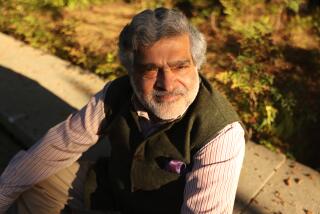A Postscript After the Final Chapter : Reminiscence: Richard Nixon’s brother and cousin meet at his grave and recall times long ago.
- Share via
YORBA LINDA — They came by the thousands Thursday to admire the flower arrangements, inscribe comments of grief and appreciation in the guest book, and stand at Richard Nixon’s freshly sodded grave the day after he was laid to rest.
Some who came to grieve for the 37th President as the Richard Nixon Library & Birthplace reopened for the first time since Nixon’s death knew only his public face and spoke quietly of the inspiration he brought them.
“I just thought it would be nice to pay my respects,” said Jan Pitts, who was visiting from Hawaii and watched as workers placed the gravestone and sod on Nixon’s resting place just before the library opened its doors about 10:30 a.m.
Others came to experience a more private grief. The former President’s brother Edward, 63, the lone survivor of the five Nixon boys, arrived about 11 a.m. to startled cries of recognition and a few backslaps from the line of visitors snaking through the parking lot.
After an emotional embrace with his daughter at the grave, Nixon turned to find Charles Milhous, 82, a first cousin of the Nixons who lives in Turlock and took his first-ever tour of the library Thursday.
Throwing his arm around Milhous, Nixon guided him up to the attic of the family’s former home, a small clapboard farmhouse, to talk away from the public eye.
“Charles, you’ve slept in the attic. Come on up with me,” he said.
Milhous, who attended Wednesday’s funeral services with his family, reminisced about his childhood years with Richard Nixon--playing football, skinny-dipping on a summer outing near Lancaster, and working in the Nixon family’s Whittier store when Richard went off to Duke University law school.
He praised the outpouring of public support for his cousin, younger by a year and a week.
“After Watergate, I got to thinking that would be the final thing that was remembered,” said Milhous, a retired machinist and custodian who sported a windbreaker and straw hat. “I thought they gave him a great honor. Even President Clinton gave him credit.”
He fondly remembered the time a dog gave him a vicious bite on the arm and Nixon, then practicing law in La Habra, jokingly encouraged him to sue. Milhous said his only criticism of his cousin was his free use of profanity.
In the first hours after the reopening Thursday, more than a thousand people filed through the library and birthplace, snapping pictures, videotaping the condolence wreaths sent by governments from Poland to Morocco and shedding tears in remembrance of a man many said they always stood by.
Thousands more continued coming throughout the day, a library volunteer said.
Bob Debiase, 50, of Playa del Rey, clutched a single rose as an offering to “the most forceful and toughest President we had.” Sally Lemmon of Murietta came with a bouquet of white and purple flowers, courtesy of her neighbors’ garden.
“They saw me out there clipping,” she said.
Ursula Butz, 56, of Garden Grove, and Elfriede Friesenhan, 57, of Fountain Valley, wandered through the grounds in search of the wreath sent by Russian President Boris Yeltsin.
Butz, who had saved her final photo for the wreath, said she agreed wholeheartedly with the inscription on Nixon’s gravestone: ‘The greatest honor history can bestow is the title of peacemaker.’
“He has been a peacemaker. He has had tremendous guts, even when he was maligned,” she said.
The grass roots support visible in the mix of visitors of all ages and ethnicities even appeared to be working some magic on Nixon skeptics.
“I’m amazed, and I’ve changed my mind now on Nixon totally,” said Mary Dobashi, 42, who lives right near the library. “He really wasn’t such a bad guy.”
Many emerged from the library carrying the tell-tale green shopping bags from the library bookstore, which was swamped with visitors throughout the day.
Alan Rockman, 40, of Upland, bought an 8-by-10 inch photograph of Nixon that he plans to frame, a ruler decorated with pictures of famous Nixon moments, and a copy of a 1991 speech Nixon gave on foreign policy, dubbed “A War About Peace.”
“I was always brought up to kind of champion the underdog. . . . I was a Nixon supporter even in the days when he didn’t have many,” Rockman said. “He was one of us, one of the American people.”
Others, whose lives had brushed even briefly with Nixon and his family, concurred.
“It shows you can come from a humble beginning and rise up,” Adeline Aldrich-Linn, 79, said after walking through the clapboard house that Nixon’s father had built from a kit.
Aldrich-Linn remembers those beginnings. She attended Whittier High School with Nixon, whom she remembered as a shy and gentle student and an ace orator who had signed her yearbook.
Doris Irion, 67, a Montana delegate to the 1960 Republican National Convention, remembered how Nixon arranged to be photographed with each and every delegate.
“I was wearing a big straw hat, and he said, ‘Your hat is lovely. It has a very attractive effect on a short lady,’ ” said Irion, now of Tarzana. “I thought that was a rather personal remark. He was a unique person. I had suspected there were lot more people who supported him than ever were heard from.”
But as supporters took in the signs of love and support for Nixon, many had one regret.
“I think it’s unfortunate that Nixon didn’t know how people felt, that the silent majority waited this long to speak up,” said Elaine Graydon, 57, who flew from San Antonio to pay her respects.
More to Read
Sign up for Essential California
The most important California stories and recommendations in your inbox every morning.
You may occasionally receive promotional content from the Los Angeles Times.











